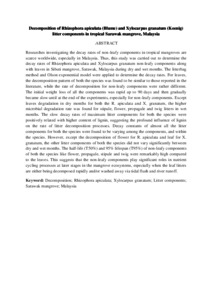Citation
Mustafa Kamal, Abu Hena and Idris, Mohd Hanafi
(2016)
Decomposition of Rhizophora apiculata (Blume) and Xylocarpus granatum (Koenig) litter components in tropical Sarawak mangrove, Malaysia.
In: 4th Mangrove & Macrobenthos Meeting (MMM4) 2016, 18-22 July, 2016, St. Augustine, Florida. .
Abstract
Researches investigating the decay rates of non-leafy components in tropical mangroves are scarce worldwide, especially in Malaysia. Thus, this study was carried out to determine the decay rates of Rhizophora apiculata and Xylocarpus granatum non-leafy components along with leaves in Sibuti mangrove, Sarawak, Malaysia during dry and wet months. The litterbag method and Olson exponential model were applied to determine the decay rates. For leaves, the decomposition pattern of both the species was found to be similar to those reported in the literature, while the rate of decomposition for non-leafy components were rather different. The initial weight loss of all the components was rapid up to 90 days and then gradually became slow until at the end of the experiments, especially for non-leafy components. Except leaves degradation in dry months for both the R. apiculata and X. granatum, the higher microbial degradation rate was found for stipule, flower, propagule and twig litters in wet months. The slow decay rates of maximum litter components for both the species were positively related with higher content of lignin, suggesting the profound influence of lignin on the rate of litter decomposition processes. Decay constants of almost all the litter components for both the species were found to be varying among the components, and within the species. However, except the decomposition of flower for R. apiculata and leaf for X. granatum, the other litter components of both the species did not vary significantly between dry and wet months. The half-life (T50%) and 95% lifespan (T95%) of non-leafy components of both the species like flower, propagule, stipule and twig were remarkably high compared to the leaves. This suggests that the non-leafy components play significant roles in nutrient cycling processes at later stages in the mangrove ecosystems, especially when the leaf litters are either being decomposed rapidly and/or washed away via tidal flush and river runoff.
Download File
![[img]](http://psasir.upm.edu.my/53873/1.hassmallThumbnailVersion/Decomposition%20of%20Rhizophora%20apiculata%20%28Blume%29%20and%20Xylocarpus%20granatum%20%28Koenig%29%20litter%20components%20in%20tropical%20Sarawak%20mangrove%2C%20Malaysia.pdf)  Preview |
|
Text
Decomposition of Rhizophora apiculata (Blume) and Xylocarpus granatum (Koenig) litter components in tropical Sarawak mangrove, Malaysia.pdf
Download (84kB)
| Preview
|
|
Additional Metadata
Actions (login required)
 |
View Item |

